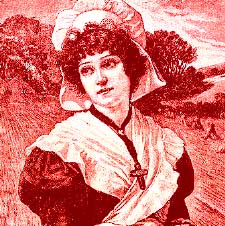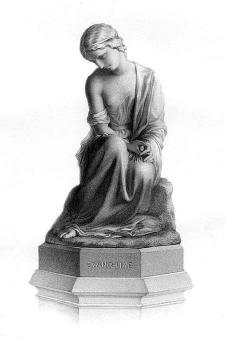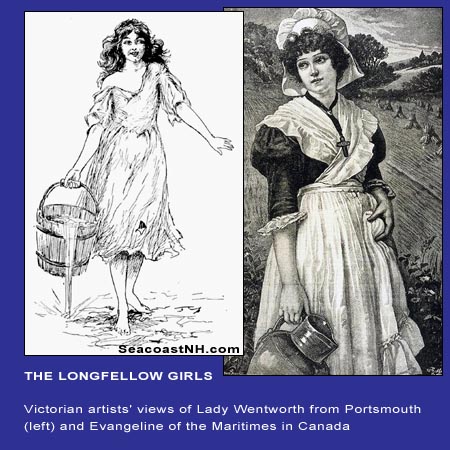|
FRESH STUFF DAILY |
|
|
||
|
|
||
|
|
||
|
SEE ALL SIGNED BOOKS by J. Dennis Robinson click here |
||
A poem about a fictional Canadian heroine still has connections to the local Seacoast. The poet was from Maine. He wrote about New Hampshire and we inherited lots of Arcadians when the Brits took control. New England and "The Maritimes" will always be linked. Here’s that story.
In comparing Canada to New England elsewhere on this web site, I ran out of space to mention poor Evangeline. The poem by the same name is among the national treasures of maritime Canada, penned by New England poet Henry Wadsworth Longfellow. Longfellow was always on the lookout for a melodramatic topic for one of his bestselling ballads. My only copy of "Evangeline" is part of a two-volume hardcover collected works edition that – I’m not exaggerating here – weighs 20 pounds. One of the books is twice the size of my laptop computer and the cover itself is so heavy that it has been dangling by a thread for 100 years.
Some Acadians buried money and heirlooms in the fertile soil in hopes of recovering it later, but the British found the loot. You can imagine Longfellow drooling at the symbolism of farmers burying money. Families tried to stay together, but were driven apart forever. A good ballad needs a good plot and this one was the 19th century poetic equivalent of a TV mini-series. Evangeline herself is a fictional device dropped into the middle of beautiful rustic scenery and turbulent times in Canadian history. It’s a moment the English prefer not to talk about, which suited Longfellow just fine. Remember, he also wrote about Hiawatha, Miles Standish, Lady Wentworth and Paul Revere. Longfellow got the idea from Nathaniel Hawthorne, another writer with an eye for good story-starters. The epic poem is way too long for this trim little publication. It was published in 1847. Evangeline, to make matters romantic, is separated from her family and her lover. The story is reportedly based on the lives of Emmeline Labiche and her love, Louis Arceneaux. If you think you’ve got problems – read Evangeline. I don’t want to give away too much of the plot, but it includes a long sea voyage, plenty of hopeless searching, a lot of angst, a nunnery, a dramatic reunion, some insanity and eventual death. Evangeline was a big hit in New England, although it did not fair well in Western Canada were it was banned from the schools. British Canadians took on Longfellow for his poor telling of history. True enough. Longfellow never let the facts get in the way of his ballads. But the fact was that as many as 6,000 Acadians were deported and many of them found their way into coastal New England communities, bringing their rich French cultural heritage with them. There are lots of editions of the book. Evangeline became the ultimate pre-Raphealite beauty with long flowing hair. She is depicted, much like Joan of Arc, as the perfect hybrid of the Madonna and a silent-film sex goddess. In 19th century engravings she has that innocent milk-maid look, much as Portsmouth’s "Lady Wentworth" was described in another Longfellow poem. In an 1855 engraving she appears as a draped nymph gazing forlornly at the ground, her bosom half exposed like Janet Jackson with no Justin Timberlake.
Seacoast locals can see a statue of Longfellow in the center of nearby Portland, Maine and visit his homestead, now a local museum. If you tour Nova Scotia, a good chunk of the province takes you along the Evangeline Trail filled with reminders of the Acadian tragedy, and of course, including a large brass statue of the fictional Evangeline. The poem opens with the line – "This is the forest primeval" – and you can find the whole thing reproduced on a number of web sites. Or, if you have a pickup truck, I can lend you my copy.
READ: Full text of Evangeline poem
Please visit these SeacoastNH.com ad partners.
News about Portsmouth from Fosters.com |
| Wednesday, April 24, 2024 |


|
Copyright ® 1996-2020 SeacoastNH.com. All rights reserved. Privacy Statement
Site maintained by ad-cetera graphics






 Evangeline was unlucky enough to live in the Canadian Maritimes during the famous "Expulsion of the Acadians" in 1755. That’s when the British, victorious
Evangeline was unlucky enough to live in the Canadian Maritimes during the famous "Expulsion of the Acadians" in 1755. That’s when the British, victorious  You can buy everything Evangeline in Canada; her image has been painted by Currier & Ives, appeared on comic books and even embossed into shapely soda pop bottles. There is a film version, of course, and it stars Doloris del Rio from 1929. There is a musical version too.
You can buy everything Evangeline in Canada; her image has been painted by Currier & Ives, appeared on comic books and even embossed into shapely soda pop bottles. There is a film version, of course, and it stars Doloris del Rio from 1929. There is a musical version too.















